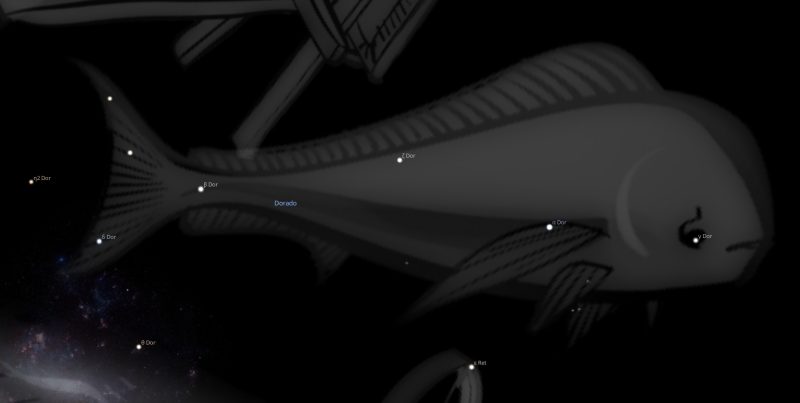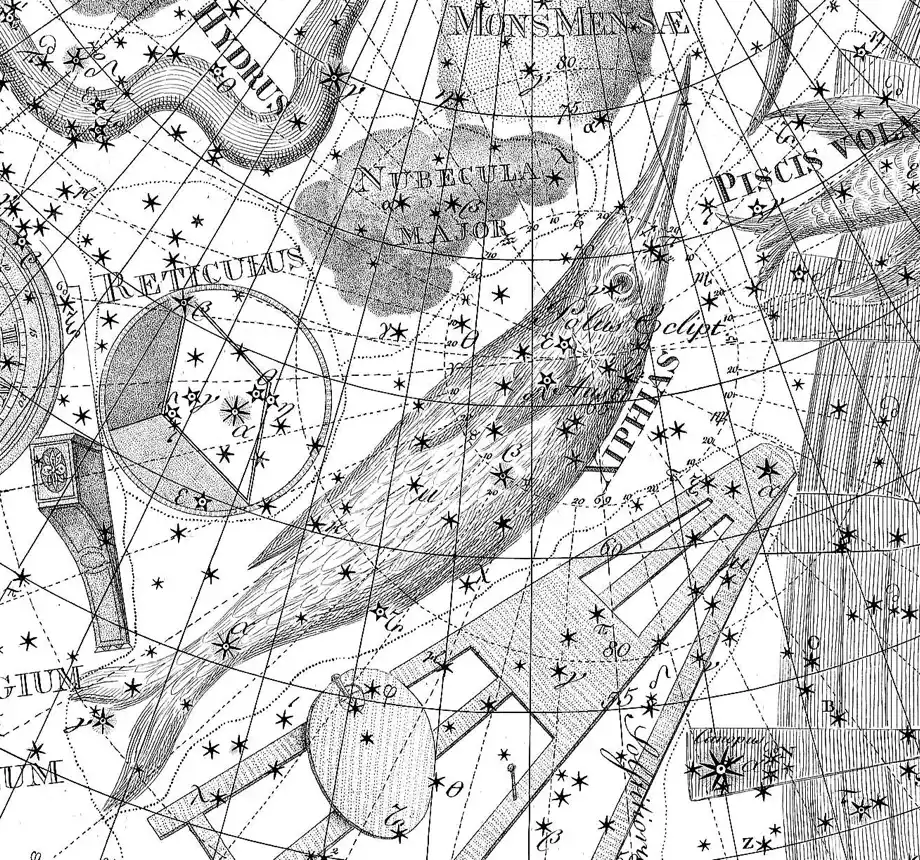FIXED STARS: Major Stars | 1000+ Stars | Constellations | About
Constellation Dorado the Goldfish is a southern constellation bordering Pictor, Mensa, Reticulum, Horologium and Caelum.Dorado was introduced by Johann Bayer in 1603, and it remains one of the 88 modern constellations. It spans 60 degrees of the zodiac in the Signs of Aries, Taurus and Gemini.
Abbreviation: Dor
Genitive: Doradus
Dorado Constellation Stars
| 2000 | 2050 | Star | Name | Sp. Class | Mag. | Orb |
|---|---|---|---|---|---|---|
| 26♈30 | 27♈23 | δ Dor | A7 | 4.34 | 1°10′ | |
| 06♉34 | 07♉17 | γ Dor | F0 | 4.26 | 1°20′ | |
| 07♉51 | 08♉34 | α Dor | A0 | 3.30 | 1°40′ | |
| 18♉42 | 19♉26 | ζ Dor | F7 | 4.71 | 1°00′ | |
| 22♉10 | 22♉55 | β Dor | F4 | 3.76 | 1°30′ |
Dorado Astrology
Robson
History. Added by Bayer in 1604.
Influence. It gives penetration and a keen wit, fondness for appearance, artistic ability, but danger of obstacles and hindrances. [1]
Allen
Dorado, the Goldfish, first published by Bayer among his new southern figures. The word is from the Spanish, and refers not to our little exotic cyprinoid, but to the large coryphaena of the tropical seas, of changing colors at death.
The alternative title Xiphias, the Swordfish, I first find in the Rudolphine Tables of 1627; Halley used it, in addition to Dorado, in his catalogue of 1679; Flamsteed gave both names in his edition of Sharp’s catalogue; and the modern Stieler’s planisphere still has Schwerdtfisch. Xiphias, however, had appeared in astronomy in the first century of our era, for Pliny [II.89] applied it to sword-shaped comets, as Josephus [Bell. Jud. VI.5.3] did to that “which for a year (!) had hung over Jerusalem in the form of a sword,” — possibly Halley’s comet of A.D. 66.
The Rudolphine Tables and Riccioli catalogued here 6 stars of 4th and 5th magnitudes, but Gould 42 from 3.1 to 7.
The head of Dorado marks the south pole of the ecliptic, so that, according to Caesius, the constellation gave its name to that point as the Polus Doradinalis. Within 3° of this pole is the very remarkable nebula 30 Doradūs, that Smyth called the True Lover’s Knot, although now known as the Great Looped Nebula, NGC 2070, described by Sir John Herschel as an assemblage of loops and one of the most extraordinary objects in the heavens, — “the centre of a great spiral.”
ε appears in Reeves’ list as Kin Yu, but this star being only a 5th‑magnitude, and these words signifying a Goldfish, they doubtless were designed for the whole figure introduced into China by the Jesuits.
ζ, a 5th‑magnitude, bears the Chinese title Kaou Pih. [2]
References
- Fixed Stars and Constellations in Astrology, Vivian E. Robson, 1923, p.43.
- Star Names: Their Lore and Meaning, Richard H. Allen, 1889, p.201-202.

